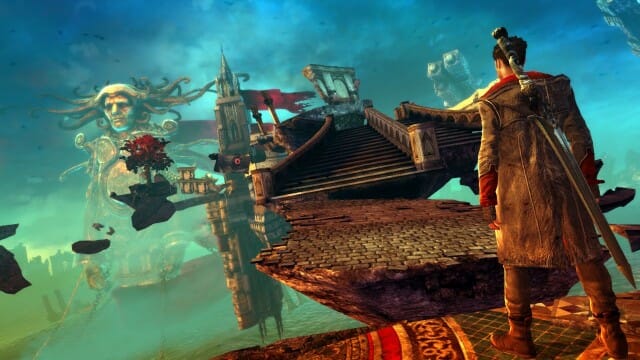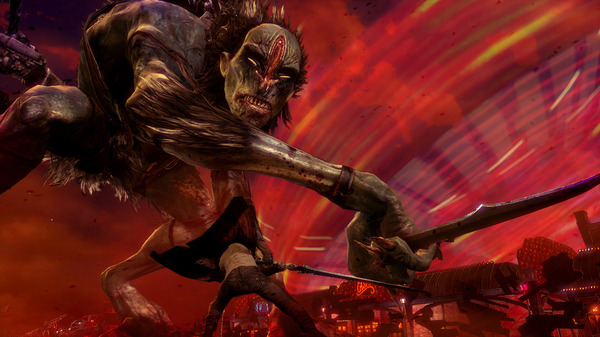
Devil May Cry aims for excess.
It’s the all-caps stencil type that bleeds onto red backgrounds, the demon screams calling out your combo milestones over industrial music and dubstep. DmC wants to evoke a raw aesthetic, rooted in rebellious nihilism and teenage angst.
The game varies between cutscenes, combat sequences and sections where I briefly explore its environments. Those environments are gorgeous, and I frequently stand at the edge of platforms to stare at this world for minutes at a time. Exploring these areas creates an experience that goes beyond slicing demon babies with axes. Omnipresent blur effects make DmC’s environments feel smooth, and that softening of the game’s cool palettes creates a soothing counterbalance to the hypnotic energy of its moving objects. It portrays our world as distorted and dysfunctional in ways that can be captivating, adding credulity to the game’s mythic, supernatural narrative.
Combat in DmC is a rapid stream of momentum, where weapon changes are immediate and transitioning between ground play, hooking and juggling is seamless. DmC delivers instant gratification. Yet, such momentum means that my brain is turned off, that I’m staring blankly at my TV while I mash the triangle button and the circle button and the R1 button. At first, I enjoy levelling my combos and indulging in the game’s addictive feedback, but DmC’s combat is absolutely incapable of holding itself up for long periods of time. Boss battles employ the design arc of evading attack patterns, hitting weak spots to paralyze the boss, slashing freely, and then repeating the sequence. It’s dull and uninspired, save for a few gems. The enemies I fight are one-dimensional beings with no reason for their existence other than trying to kill me. That makes sense in a way, as they really are manifestations of the antagonist’s demonic will, but knowing that doesn’t make it easier to tolerate the waves upon waves of one-dimensional enemies that exist purely to kill. Combat quickly becomes merely a means of progression, void of any value in itself, and I start to feel like what I’m doing is pointless.
This is DmC’s biggest issue. There’s no strong thematic context behind what I’m doing, so everything I do feels trite and meaningless. Its universe may be pretty, but it lacks thematic consistency. DmC will tell me that a level is a prison where imprisoned souls are “re-educated” but I don’t see any souls being imprisoned or re-educated. It will tell me of a factory where a poisonous drink spiked by demons is made and consumed by millions, but the idea of an ignorant and uninformed culture of consumerism that it hints to in its corresponding cutscene is never explored.
DmC’s plot feels like a compilation of quest-lines instead of a story born out of characters and motivations. It’s rooted in the shallow arc of a forbidden love between warring Angel/Demon and Heaven/Hell binaries. Dante as a protagonist periodically flips between a witty, action game archetype and a real person. When he’s the former, Dante can be sincerely funny. There’s clearly an attempt to flesh out the character into something meaningful, but DmC’s exploration into Dante’s nature beyond his jokes amount to a 30 second animation and a few vague statements spread throughout the game and backed by horrendous sad piano music. Moments of genuine nuance do appear, but they’re few and far between. The motivation that turns Dante from a confused asshole into a good guy who wants to save the world is shaky. DmC doesn’t show how Dante fosters a view of humanity that would motivate him to want to save it. His views and opinions don’t develop over time—they’re shifted by a simple, singular event, and then stay constant. This hurts any idea of Dante as a character who has layers.
His brother Vergil is quite dull, as his dialogue tends to be overdramatized and his diction formalized to the point where he becomes a caricature. In a way, he’s meant to complete the sibling binary: the formal, well-kept twin brother with leadership skills as the antithesis to Dante’s rough, unkempt and rebellious nature. He’s Cyclops to Dante’s Wolverine. At times, he seems to be incapable of navigating a moral compass, too fixated on his specific goals to create empathy for others. These are small points where Vergil becomes interesting, but they don’t appear very often. And by the time DmC takes full advantage of it, it’s not as impactful.
Kat is the token woman (at least when you exclude deformed monsters) who mostly acts in the all-encompassing support role. She’s great at providing instructions and being followed (“follow me” is a line heard many times), but she isn’t so great at demonstrating her own agency as a person. Kat shows no goals, no wants or desires as an individual—she mostly acts as an extension of Vergil’s desires, or in relation to Dante. This doesn’t feel natural, like an embedded part of her character forged by her life experiences. Rather, it feels constructed and unjustified, adding nothing meaningful to her or to the game.
Kat points to DmC’s larger issues with portraying women. It tends to reduce women to an incubator status, and falls into the tropes of the mystical pregnancy and the magical Negro. These missteps don’t add to the game’s sense of Satanic excess or give credibility to its tongue-in-cheek elements, nor are they clever. They eat away at its narrative and disconnect you from the game.
When the use of its tone is thoughtful, DmC allows itself room to discuss interesting ideas. But it waves these thoughts in my face, then immediately forgets them, losing its appeal very quickly, and leaving a game that feels shallow and void of purpose.
DmC: Devil May Cry was developed by Ninja Theory and published by Capcom. Our review is based on the PlayStation 3 verison. It is also available for the Xbox 360 and PC.
Zolani Stewart writes about games, typography, and culture throughout the corners of the internet. You can follow his musings @Fengxii
